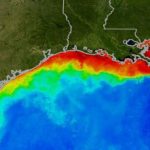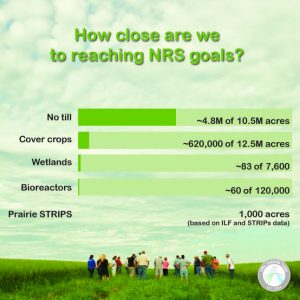 Hot off the press! National Geographic reports the dead zone in the Gulf of Mexico is the largest ever. And all science points to agriculture in the Upper Midwest as the major source of nitrogen contributing to this dead zone.
Hot off the press! National Geographic reports the dead zone in the Gulf of Mexico is the largest ever. And all science points to agriculture in the Upper Midwest as the major source of nitrogen contributing to this dead zone.
If this doesn’t demand straight talk with farmers then I don’t know what does. It’s time for government agencies and agribusiness to be honest with farmers. We all need to quit pretending that stabilizers, split application and spring application of nitrogen is the answer to water quality. All that may help with greenhouse gas emissions, but it does little to move the needle on water quality. I am not suggesting farmers shouldn’t use nitrogen management tools; every little bit helps. But let’s admit it… those practices will never get us to the necessary water quality standards. If we sell nitrogen management as the antidote for water quality, then we are misleading farmers. Universities are already telling it like it is.
Dr. Laura Gentry, University of Illinois says that the nutrient reduction strategy will only achieve 6% to 8% of our water quality goals. Dr. Matt Helmers, Iowa State University, stresses the  importance of using alternative practices to meet Iowa’s Nutrient Reduction Strategy (NRS). Dr. Helmers focuses on practices like no-till, cover crops, wetlands, bioreactors, and permanent vegetation. It is going to take more than just our universities to lead the way. As an agricultural community, we all have obligations to help farmers. Farmers have neither the time, nor the resources, for anything but straight talk.
importance of using alternative practices to meet Iowa’s Nutrient Reduction Strategy (NRS). Dr. Helmers focuses on practices like no-till, cover crops, wetlands, bioreactors, and permanent vegetation. It is going to take more than just our universities to lead the way. As an agricultural community, we all have obligations to help farmers. Farmers have neither the time, nor the resources, for anything but straight talk.
 Agronomy Doctor
Agronomy Doctor
Head of nail hit. Thank you Tom.
There is a tenancy for farmers and those of us in agriculture to take this personally and get defensive, and thus avoid the issue. It is no one’s fault. It is all too real. We need to fix it. The tools are at hand. We can do it. There are farmers doing what needs to be done right now. And profiting. Let’s go see what they are doing.
Thanks for highlighting this important issue Tom. Did Dr. Gentry say that nutrient management could only achieve 6-8% of water quality goals in the Nutrient Reduction Strategy? I was a little confused by that sentence.
Mark, I am trying to get confirmation but I believe it is 6 to 8% towards the 45% reduction outlined by the Nutrient Reduction Strategy.
Tom, this is a definite blow to our idea that what we are doing is helping to cut the growth of the “dead zone”. How much longer can this continue before we reach a point of no return? Maybe an answer to our commodity glut and low prices is a true production limit. How many acres would it take to return to a state of natural vegetation to reduce the growth in the “dead zone”? How much reduction in commercially applied nitrogen and phosphorus would it take to do the same? How can we get a true measurement of the fertilizer loss/acre, on what soils, and in what states to get a true picture of where this runoff is coming from? If we can get answers to these questions, we can begin to right a terrible disaster in the making. Scientific data to correct what we are doing should be the goal first. Then create the correct model to make it happen without destroying agriculture. My guess is the political fallout would prevent the allocation of resources needed to determine the source and the corrections needed to be implemented to make the Gulf whole again.
AHMEN!
Tom, I appreciate your straight talk. It’s worth pointing out that many farmers once solidly opposed to the strategy to fix the dead zone in the Chesapeake Bay are now on board to keep those strategies in place because they’ve worked the bay and they’ve allowed farmers to remain productive. There is hope. There is a path forward. And straight talk like yours is one of the necessary steps to solving this and related problems.
You are right that e farmers have to change some of our management. I am committed to putting cover crops on as many acres as I can every year. Last year I did 100%. Our farming is not the only reason there is a dead zone. Building more levees throughout the Mississippi watershed means more floodwaters carrying nutrients and soil stay in the river instead of spreading out on floodplains. We will never stop all losses and torrential rains seem to come more often. We need to change and improve what we can. However to think the dead zone is getting bigger because farmers are doing a poorer job is wrong. I don’t hear anyone talk about the whole story.
Steven, I agree. I also do not think farmers are doing a poorer job. I think the increase in nitrogen losses have more to do with changes in weather patterns. Research shows that spring rains are getting larger and more intense. That leads to more nitrogen leaching. But the problem with the dead zone still exists regardless of the reason.
Thank you, thank you. It’s obvious now that this reality needs to be placed in front of the general public, as well as farmers, again and again and again. You did it well.
Tom. Your comments are on target. You made no excuses to defend the majority of current agriculture management practice occurring across the Corn Belt. Agriculture leadership needs to recognize and accept that many more practices need to be implemented that are effective in reducing nutrient contamination of surface waters The LGU research community needs to be adequately funded to develop and demonstrate nutrient reduction strategies that can be readily moved from field research to on-farm implementation. Keep sharing the advocacy in your blog!
Thanks Jerry, I appreciate your encouragement and comments.